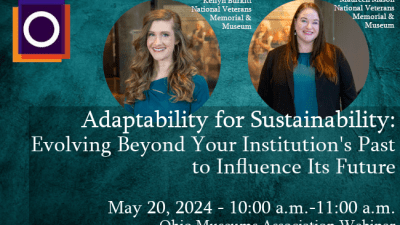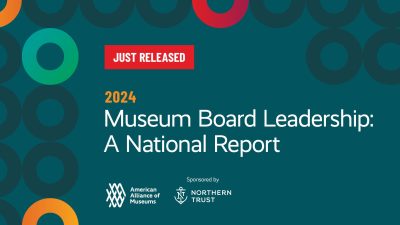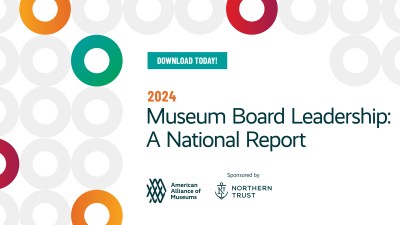
Adults keep saying we owe it to the young people to give them hope, but … I don’t want you to be hopeful. I want you to panic. I want you to feel the fear I feel every day. … I want you to act as you would in a crisis. I want you to act as if the house was on fire, because it is. —Greta Thunberg, who became a climate activist at the age of 15
This article originally appeared in Museum magazine’s January/February 2024 issue, a benefit of AAM membership.
How can museums reduce their own emissions and inspire the public to take action?
The climate crisis poses an overwhelming threat to museums and the communities they serve. Museums’ collections constitute a vast seedbank of human civilization, creativity, and accomplishments. Protecting those seeds will entail a commitment to decarbonizing the future—replacing our dependence on fossil fuels with sustainable systems.
How can museums decarbonize their own operations? How can they inspire people to take meaningful action in response to the climate crisis, even as they prepare to live in a profoundly disrupted future?
The Challenge
How we talk about the world shapes how we think about the world: nowhere is this more evident than the evolution in language describing climate change. In 2019, The Guardian, Britain’s equivalent to The New York Times, announced that to more accurately describe the environmental challenges facing the world, it would henceforth refer to the “climate emergency” or “climate crisis” rather than to “climate change.” Now we are creating a whole new terminology to describe the impact of this crisis on mental health, grouped under the heading of climate trauma. This taxonomy includes climate anxiety (a sense of impending dread); solastalgia (distress at the changes in one’s home environment); and eco-grief (anguish and despair at the deterioration of the places we love).
Scientists around the world are struggling to bracket the best and worst possible outcomes of the current climate trends, but it’s clear that even the rosiest credible projections are grim. The Inevitable Policy Response consortium concludes that by 2050 the world will likely achieve the Paris Agreement goals to limit global warming to an increase of 1.5° C to 2° C above preindustrial levels. This may be unduly optimistic, however, in light of the fact that, as the UN Environment Programme reports, every one of the 196 countries that signed on to the agreement is falling short of these goals. At the pessimistic end of the spectrum, Columbia University scientist James Hansen, who briefed the Senate about global heating way back in 1988, predicts we are approaching a “new climate frontier” with temperatures higher than at any point in the past million years.
This crisis poses an immediate and deadly threat. Record temperatures are directly responsible for a soaring number of heat-related deaths and record-breaking wildfires, drought, and flooding. In the near term, these changes threaten economies, ecosystems, and agriculture. We are fast approaching irreversible tipping points, including the collapse of ice sheets and ocean circulation, loss of glaciers, and the dieback of coral reefs and rainforests. Warming, combined with habitat destruction and introduction of invasive species, has triggered the sixth mass extinction in Earth’s history, which may wipe out up to a million species. For humans, a warming world increases disease, injury, and death rates. It also contributes to a global crisis in mental health, with rates of suicide rising in step with global temperature, climate disasters triggering acute stress and PTSD, and climate disruptions leading to long-term depression and anxiety.
Industrialization has flooded the atmosphere with CO2, getting us into this mess. Theoretically, we could dig ourselves out by capturing and storing carbon (biologically, geologically, or technologically), but so far, the majority of such projects have either failed or fallen significantly short of their goals. Many of the “carbon credits” pitched to individuals and corporations as a way to offset emissions are illusory, unverified, or temporary. Gaining control over the climate crisis, the UN Environment Programme has declared, will require urgent, system-wide transformation. That includes putting ourselves on a strict carbon diet when it comes to both public infrastructure and individual behavior. This includes, critically, curbing the consumption (for travel, meat, material possessions) that has become synonymous with success. It may require degrowth—focusing on sustainable metrics of success such as health, education, and happiness rather than economic profit.
While efforts to tackle this crisis have been slowed by climate skeptics and misinformation, relentless communication by scientists and activists is having an impact. The Yale Program on Climate Change Communication reports that public understanding of climate risk has improved since 2008, when the group first began tracking public opinion. As of 2013, the Americans who think global warming is happening outnumber those who think it is not by a ratio of nearly 5 to 1, and 60 percent understand it is caused by humans. On the other hand, climate change ranks 17th out of 21 national issues concerning Americans, trailing far behind the economy, health care costs, terrorism, and the budget deficit. How can we bump up climate action on this list of priorities and increase people’s willingness to act?
What This Means for Museums
Of paramount concern is the fact that the climate crisis is harming the communities that museums exist to serve, posing particular risk to the very young and the very old, people with disabilities or chronic medical conditions, people of color, people with low incomes, and Indigenous peoples. More than 90 US coastal communities currently experience chronic flooding, and that number is expected to rise to over 170 in the next two decades. By 2100, as many as 13 million people in the US could be forced by rising sea levels to relocate, stressing the economies, housing, and infrastructure of the cities that receive these displaced populations.
The risks facing museums themselves are clear and comprehensive. To name just a few:
- Over a third of US museums lie within 100 kilometers of the coast—a quarter in zones highly vulnerable to sea level rise and severe storms.
- Sixteen percent of Americans live in areas at high risk of wildfire—this will rise to 21 percent in the next three decades as the risk zones for fire expand. US museums, which tend to co-locate with population, face similar exposure.
- Museum buildings and HVAC systems were built for climate conditions that are rapidly becoming out of date. The stress on these systems, and costs of remediation, will only increase with time.
- As plant hardiness zones shift north, historic properties and botanic gardens face a future in which their original landscaping and collections cannot survive.
- The increase in the number of extreme heat days annually is encroaching on attendance and outdoor space rentals.
- The climate crisis is making insurance more expensive. Major insurers have already stopped writing new policies in California, Florida, and Louisiana, and this list of “uninsurable” areas is expected to grow.
- Climate risk will put additional pressure on museums racing to document and preserve archaeological sites, habitats, and endangered species.
Museums can respond to these challenges both internally, through how they operate, and externally, through how they work with their communities and influence the public.
The Carbon Inventory Project estimates that the US museum sector annually emits an estimated 4 million metric tons of CO2e, or carbon dioxide equivalent, which expresses the total greenhouse gases emitted in terms of the equivalent measurement of carbon dioxide. This is equivalent to the emissions of about 83,000 US households. As the Culture Over Carbon initiative points out, reducing those emissions by 30 percent would be the equivalent of taking three natural-gas–fired power plants offline or 271,000 cars off the road. If the entire sector reduced its annual energy consumption by 50 percent, the related emissions reductions would be equivalent to eliminating five such power plants or 452,000 passenger vehicles (more than all the registered vehicles in Maine).
There is consensus among the general public, even stronger among frequent museum-goers, that museums should be working to reduce their carbon footprints and operate in more sustainable ways. These improvements could encompass design, construction, energy use, land management, digital activities, and all other aspects of museum operations. Choices range from moving the museum to a more sustainable site to reducing reliance on travelling exhibits and collection loans. Given the tremendous carbon output tied to computation and data storage on “the cloud,” museums may also need to assess the impact of their digital practices. (Even removing images from email signatures has a measurable impact on carbon emissions.)
Some of these changes will require museums to revisit and revise old standards, which can be deeply embedded in intransigent systems. The museum sector is slowly chipping away at inflexible and unsustainable standards for climate control, but even as some museums around the globe adjust their HVAC systems to allow a greater range of temperature and humidity, many contend with loan agreements that adhere to old conventions.
There is overwhelming, broad-based support for museums of all types to educate the public about climate change. Not just science centers, natural history museums, zoos, and aquariums (as one might expect), but also art museums, history museums, historic sites, and children’s museums. No other type of institution in American life is more trusted than museums, and when it comes to information on climate change specifically, only scientists and researchers rank as more credible. (It’s always good news when science wins.)
What message should museums send when teaching about the climate crisis? It may not be as simple as making more people understand, and believe, what is likely to happen. Research suggests that if people are confronted with projections that are too depressing and scary, they disengage and are even less likely to take action. (Case in point: How did reading the opening of this article make you feel?) Some advocate “climate optimism”: fostering change by helping people believe they can make a difference, creating a positive feedback loop of action and hope.
Crafting the appropriate message is also complicated by wide uncertainties around what we face. Museums can’t assure people “if you do this and support that, all will be well.” Even if we take every recommended action, many generations will live in a significantly warmer world. However, museums can help people understand that their actions can help avert the worst-case scenario while simultaneously preparing them to live in a profoundly altered world. Museums can help people think about uncomfortable truths and feel empowered to do things that can make things better.
Carbon Management at the Nevada Museum of Art
By Colin M. Robertson, Charles N. Mathewson Senior Vice President of Education and Research
“We are learning from Indigenous artists and partners to better understand and refine our role as a cultural institution in addressing climate justice, land and water use.”—David B. Walker, CEO, Nevada Museum of Art
As a cultural institution located in Reno, the Nevada Museum of Art has a vested interest in climate action. In 2022, the nonprofit research organization Climate Center named Reno the city with the fastest-warming climate in the United States—since 1970, summer temperatures in our city have risen 10.9 degrees. We are committed to positively impacting our own micro-climate by reducing our carbon emissions and inspiring our community to learn and take further action.
Nevada’s geography, climate, and hydrogeology are embedded in our museum’s architecture and visual identity.
Our building, designed by architect Will Bruder, is inspired by a basalt rock formation endemic to the high desert of the Great Basin.
Our visual identity and branding, designed by Brad Bartlett, are based on geothermal heat maps of Reno, and the thermal data visualized on our website reflects hourly, daily, and seasonal temperature changes.
Our Center for Art + Environment, launched in 2008, stewards a substantial and growing collection of archives, special collections, and unique publications related to creative interactions between artists and the environment.
To extend the museum’s commitment to art and the environment institutionally, and to align with the Paris Climate Agreement’s imperatives to reduce waste and the world’s carbon emissions, in 2022 we worked with the Ki Futures program—an Amsterdam-based program designed for the cultural sector by the nonprofit organization Ki Culture—to produce a Sustainability Action Plan (bit.ly/NVMActionPlan) addressing climate justice and carbon accounting.
To optimize our museum’s carbon footprint, we use a comprehensive carbon accounting platform developed by nZero Inc. to analyze and ameliorate our direct and indirect emissions. nZero’s dashboard visualizes our energy consumption and emissions data in real time—a sometimes sobering exercise, given the cooling and humidification requirements in a high desert environment.
As new infrastructure comes online during the construction of our 50,000-square-foot Charles and Stacie Mathewson Education and Research Center, we anticipate our carbon footprint will improve despite increasing the overall size of our museum. One goal of our groundbreaking exhibition “Into the Time Horizon” (opening in 2026) is to reduce an exhibition’s carbon footprint by better utilizing permanent collections in combination with signature international loans and commissions.
We would like to thank nZero, the Teiger Foundation, and the Helen Frankenthaler Foundation for their support of the Nevada Museum of Art’s sustainability initiatives.
Museums Might …
Internally, as organizations and as a sector
- Measure and report on their own carbon emissions as a first step toward reduction; integrate carbon goals into their strategic and operational plans.
- Implement climate-friendly policies and procedures that minimize emissions, such as supporting remote work. (Hybrid employees who work from home two to four days per week reduce their emissions by 11 to 29 percent compared to full-time on-site workers.)
- Question the dominant paradigm that success requires growth. What would “degrowth” look like in museums? Might it entail less travel for research, fewer loans, and capping the museum’s footprint and attendant energy costs?
- Make thoughtful decisions about funding. Some wealth is tied directly to practices that fuel the climate crisis. When are grants, sponsorships, or donations an appropriate form of reparative practice, and when do they insulate individuals and corporations from the need to make fundamental changes to their business models?
- Work together as a sector to revisit expectations on climate control so that museums are not required or pressured to conform to environmentally unsustainable standards.
- Join initiatives such as We Are Still In, the Museums & Climate Change Initiative, the Climate Heritage Network, and the Coalition of Museums for Climate Justice to foster organizational and collective action.
Externally
- Use their knowledge, perspective, and trusted status to advocate for climate actions by individuals, businesses, and government.
- Motivate members of the public to take action by changing their own lifestyles and advocating for change at the local, state, and federal levels.
- Organize and host constructive community conversations, workshops, speaker series, and programs that resonate across the political spectrum and help people think critically about these issues.
- Help individuals and communities cope with the stress and grief inflicted by climate impact.
Museum examples
In 2021, the board of the Discovery Museum in Acton, Massachusetts, approved a five-year Sustainability Plan that outlines more than two dozen action steps across all areas of its operations to reduce greenhouse gas emissions and decrease its carbon footprint, reduce water usage, minimize waste generation, invest sustainably, and advocate for climate action. All these steps support the larger goal of inspiring others to climate action. A cornerstone of the plan is the installation of a 326 kWh solar array over a portion of the parking lot that generates more than 100 percent of the museum’s electricity on-site, with the excess sold to five other nonprofit organizations at a discount. The solar array, which became operational in summer 2022, represents a CO2 reduction equal to preserving 317 acres of forest. In June 2022, the museum kicked off a first-of-its-kind carbon offset program for members, staff, and volunteers and in September 2023 provided carbon offsets for all other visitors.
Each spring, the National Nordic Museum in Seattle hosts corporate leaders, policymakers, and scholars for its annual Nordic Innovation Summit. Launched in 2018, the summit strengthens ties between the technology and innovation sectors in the Nordic countries and the Pacific Northwest—two regions advancing cleantech solutions. It is now a week-long event that serves over 400 on-site attendees and thousands through a live webcast. The theme of 2023’s summit was “Sustaining Sustainability”—the idea that by doing good (through environmental, social, and governance commitments), a company can do well financially. Highlights included Governor Jay Inslee pitching business opportunities in Washington State to Nordic cleantech companies; Henrik Henriksson, CEO of H2 Green Steel, sharing how his company is reducing 95 percent of carbon emissions in the industry; and executives at Volta Truck discussing the US launch of their 16-ton, all-electric commercial vehicle. This program exemplifies how the National Nordic Museum lives its values as a neutral convener for climate-crisis cooperation.
In 2021, the Peabody Essex Museum (PEM) in Salem, Massachusetts, launched a Climate + Environment Initiative with the goal of sparking conversation, motivating action, and inspiring creative solutions. Designed to be simultaneously outward-facing and inward-looking, the initiative produces a series of ongoing exhibitions and public programs while implementing institutional protocols to mitigate climate impact, such as creating reusable exhibition design systems, offering sustainable products in the shop, and transitioning to renewable energy sources. A museum-wide staff cohort meets regularly to propose ideas to make PEM a more sustainable and climate-forward institution. PEM also hosts Salem’s annual Preservation in a Changing Climate conference with the city and has recently partnered with Mass Audubon to help establish a regional Youth Climate Leaders Club. Through its efforts, PEM seeks to be a community partner and a hub for engagement, empowering other organizations to take similar actions to confront the biggest challenge of our time.
Resources
Culture Over Carbon: Understanding the Impact of Museums’ Energy Use, New Buildings Institute, 2023
This report shares energy data from more than 130 participating institutions, including zoos and aquariums, gardens, historic sites, and five types of museums. The report also includes recommendations for energy saving strategies geared to cultural institutions. ecprs.org/engagement/culture-over-carbon
Toolkit on Sustainability in the Museum Practice, International Committee for Museums and Collections of Modern Art
Launched in 2021 and updated in 2023, this toolkit offers museums resources, tools, guidelines, and examples to promote sustainable change related to equity, inclusion, diversity, justice, environmental respect, and sustainable economic growth. bit.ly/46Or2kk








Comments